 I
was not very much familiar with Faber's speaker cables, while I know
quite well his signal and power cables. In all his production, Faber
considers three aspects as the most prominent for doing a good cable:
I
was not very much familiar with Faber's speaker cables, while I know
quite well his signal and power cables. In all his production, Faber
considers three aspects as the most prominent for doing a good cable:A speaker cables shootout
Dear audio friends,
if I was reticent to admit that power cords may influence the sound (while recently I'm convinced that they do) I was always a “believers” of the speaker and signal cable influence. The speaker cables are the longer of the audio system. which should be quite sensitive to their difference (when seen as a transmission line). Instead, the signal cables bring the smaller signals and for that reason are also sensitive. My speakers cables were homemade at the beginning, after they were a pair of cheap Monster Cable, then I had a pair of GB&L HP2CA, but just for a short period, because when I auditioned in my system the TaraLabs RSC Prime 500 I was so shocked by the quality improvement that I bought a double run of them. Until recently, I used the TaraLabs RSC 500 in my system, until Faber brought me a pair of his new reference speaker cables.
 I
was not very much familiar with Faber's speaker cables, while I know
quite well his signal and power cables. In all his production, Faber
considers three aspects as the most prominent for doing a good cable:
I
was not very much familiar with Faber's speaker cables, while I know
quite well his signal and power cables. In all his production, Faber
considers three aspects as the most prominent for doing a good cable:
the conductor material;
the shielding material;
and, most important of all, the geometry.
Faber usually uses aeronautic grade silver coated copper wire, with teflon insulator, but in his very last top production he uses also monocristal copper wire (as Acoustic Zen does). The cable he gave me to test was from his new reference line, but without using monocristal copper.
The shielding material is done with multiple layers of aluminium foils, each one containing a “drain” copper wire, as you can frequently see in the “elementary particle” lab (did you never visit CERN, near Geneve? I did).
The geometry is the aspect most developed by Faber and probably is the very secret of his cables. What I can say is that there are multiple “layers” of twisted conductor wires, separated by shielding levels and isolating foils. This particular cable have two “layers”, but I know that Faber has built also a 4 layers version, which should be much bigger and expencive.
The very first day day that I received these speaker cables my daughter immediately understood how much good they were and also tried to eat them!
|
|
|

When compared with my old TaraLabs the new Faber showed immediately how many things I was missing: there were much more details, more clean and deeper bass but over that, the soundstage was much higher and larger.
The Faber had a so better resolution than I was finally able to listen some minor problem if my system, which I wasn't aware. In particular I noted that the male voices were not so “full” in their body as it should have been. To investigate this aspect, but also to understand better the level that the new Faber speaker cables reach, I decided to run a cable shootout.
Faber provided me a couple of JPS Lab Superconductor FX, while another friend gave me his Kimber Kable 8TC, a standard reference in speaker cables.
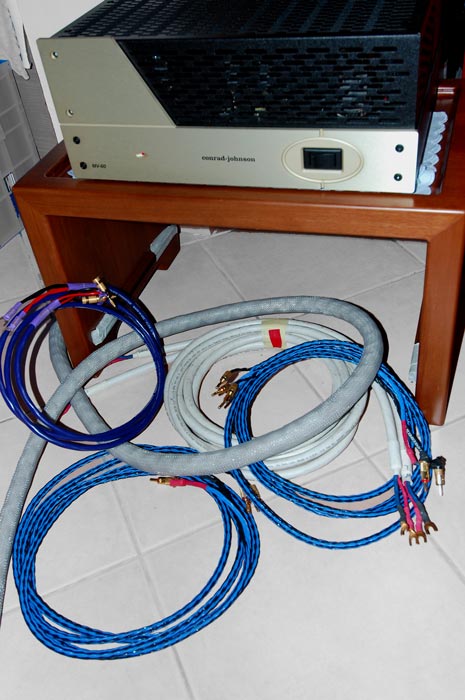 So
the contenders were my old TaraLabs RSC Prime 500, the Faber
reference speaker cable, the JPS Labs Superconductor FX and the
Kimber Kable 8TC.
So
the contenders were my old TaraLabs RSC Prime 500, the Faber
reference speaker cable, the JPS Labs Superconductor FX and the
Kimber Kable 8TC.
The JPS and the Kimber were biwiring and some adaptors has been used to connect them to my “monowiring” Acoustic Zen Adagio. On the other side, my Conrad Johnson MV60SE was accepting any kind of connectors (banana/spade or fork).
Since the JPS were shorter than the others (which were at least 3.5m long) I had to move the power amp and Faber was so kind to provide me a 2m long signal cale to connect my CJ pre with the power amp.
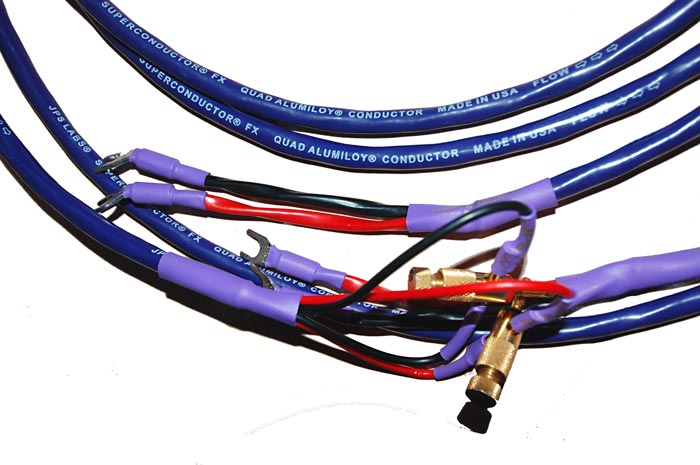
The
first comparison was among the Faber and the JPS.
The JPS is apparently a very simple cable (as geometry), but it uses a very special conductor material, which is called “Quad Alumiloy”. It should be an alloy using also aluminium and it should have a squared section. Its sound is very peculiar. If I have to condensate it in a few words I would say “bristly” and “clear”. Bristly in particular on the mid-low frequencies,where, for example, you can hear the cello sound as really coming from a piece of wood. Clear in particular on the mid and high frequencies, where it seems to avoid any confusion among different instruments. On the other side, I had the impression that this cable was not able to reproduce the very low bass and very high frequencies as the Faber did, and that gave the feeling of a lower resolution. But even so, the JPS FX sounded in a fashion way, maybe not too much realistic, but alltogether very pleasant.
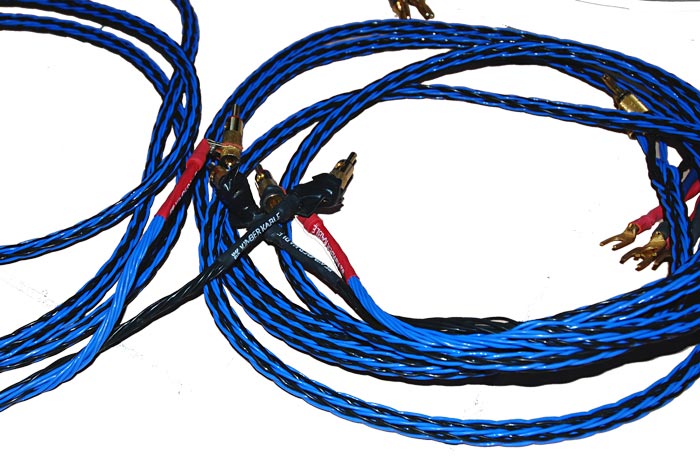 Finally
come the Kimber Kable 8TC, which is considered a classic gear in his
price category.
Finally
come the Kimber Kable 8TC, which is considered a classic gear in his
price category.
Unfortunately this was more a tragedy than a test. In fact, after about 3 minutes of listening, during one of the tracks previously used as references, one of the four output tubes (Svetlana “winged” 6550) of my CJ MV60SE blow-up and the shoot-out had a very unpleasant end.
The killer music was “Miserlou” by Quadro Nuevo 'Mocca Flor', GLM FM 110-2, which is quite demanding in low frequency power, while the volume was high but not too much (preamp set to have 104 dB SPL for 0dB of musical signal, that is 87 speakers -9 pre + 26 amp).
It was a fatality that this happened when using the 8TC and not previously with the same music and volume setting? The 8TC is quite a capacitive cable but I can't believe that the CJ stability can't work out some 1200pF! When the spare tube arrived from the seller (in fact the amp was only 4 months old) everything worked as before, but I had no more the Kimber Kable 8TC with me, so it was not evaluated in this shoot-out.
Conclusions:
The shoot-out contenders were not so many, even because of the CJ MV60SE failure which stopped it. Among the three tested above (but there is a very interesting addendum below) the Faber Reference resulted the more transparent, with higher details in both the audio extremes. The JPS was very pleasant and it must be considered from people who has a Solid State amp with generous bass and a little harsh or cold top frequencies. The old TaraLabs was not a so high-rez component as the others, so the Faber was the real winner. It was also a winner for the WAF (wife acceptance factor), since my wife liked much more this beige cable than the other dark or electric blue Faber cables that she has seen until now. She only said that it is too “big”...
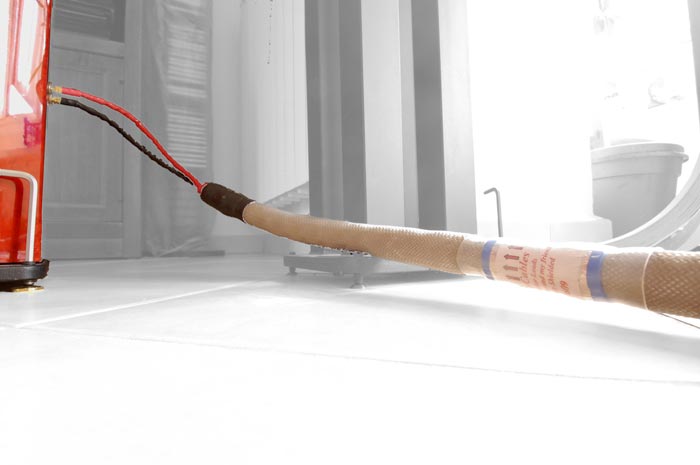 The
only advice that I can issue against this cable is that it is more on
the “lively” side than on the “controlled”
one, so if you want to put attention on the midrange part you could
prefer a more damped cable, but you will probably lost a wide part of
the soundstage.
The
only advice that I can issue against this cable is that it is more on
the “lively” side than on the “controlled”
one, so if you want to put attention on the midrange part you could
prefer a more damped cable, but you will probably lost a wide part of
the soundstage.
I don't know the price that Faber is asking for these top cables, but surely it will cost above 1 kEuro or also much more if you chose the 4 layer version. Ask via email directly to “info at fabercables.com”. Maybe that people don't want to spend so much money on a relatively small cable company, but I still think that the commercial cables of this level would cost much-much more!
A slovenian follow up:
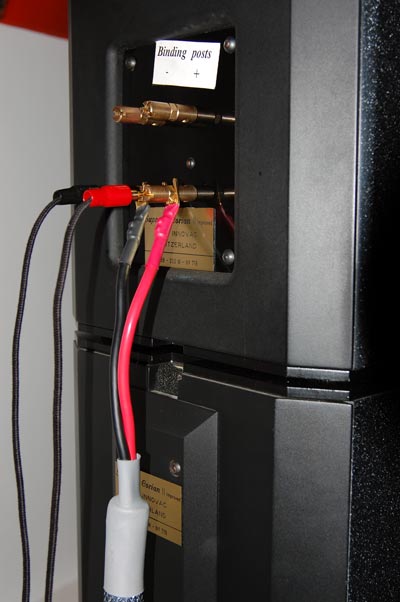 Few
days ago I went to Nel Audio (Ljubljana, SLO) to pick-up a *small*
Kronzilla SD power amp for a two weeks home test (stay tuned for a
review).
Few
days ago I went to Nel Audio (Ljubljana, SLO) to pick-up a *small*
Kronzilla SD power amp for a two weeks home test (stay tuned for a
review).
Before to take the amp I wanted to listen the Nel Audio top system and then we tried to replace the speaker cable with the Faber reference under test. The Nel Audio system was very good, including: a Burmester 001 CD-player (14 k$), Mod Wright SLW9.0SE line preamp and Kronzilla SD power amp (around 8.5 kEuro for 22W).
As speakers we auditioned both the new Reference 3A Grand Veena (~9 kEuro) and the 9 years old Reference 3A -Innovation- Supreme Corian II Improved (~5 kEuro used), which we found far superior, at least in that system/room. You can see this 2-way+subwoofer system in the pictures.
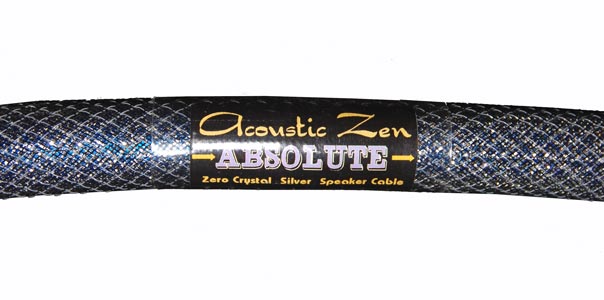
Cables
were all from Acoustic
Zen and Dueland,
but in particular the speakers cable were the AZ Absolute (2.9 k$ for
2.7+2.7m). The sound was really good, with lots of details but still
conserving the music as a whole. Every component (starting from the
CD-player) was hi-rez and my FIM SACD 029 (played as simple CD)
sounded really well. After a while we replaced the AZ Absolute with
the 3.7+3.7m of Faber Reference. The first 5/10 minutes were
necessary for a minimum break-in (the cable become more “open”)
and then I immediately feel as if the music was playing louder. But
no, the volume was set at the same level. Simply, the Faber Reference
was carrying much more informations and that increased the perceived
dynamic.

Listening “High Life” from Jazz at the Pawnshop (Proprius/FIM) was much more involving then before. For me there was no way: the Faber was superior to the AZ Absolute! For Boris (Nel Audio), he said that he was more used to the more controlled AZ sound, even if he admitted that the Faber was at least at the same -very high- level. Of course, he added that few people will spend so much money on a relatively unknown brand as Faber's Cable with respect to a well known hi-end product like Acoustic Zen, but can we still call Faber's cable unknown when at the very recent Milan Top Audio there were 3 rooms fully cabled by Faber plus others at least partially “Fabered”?
Tino © September 2008